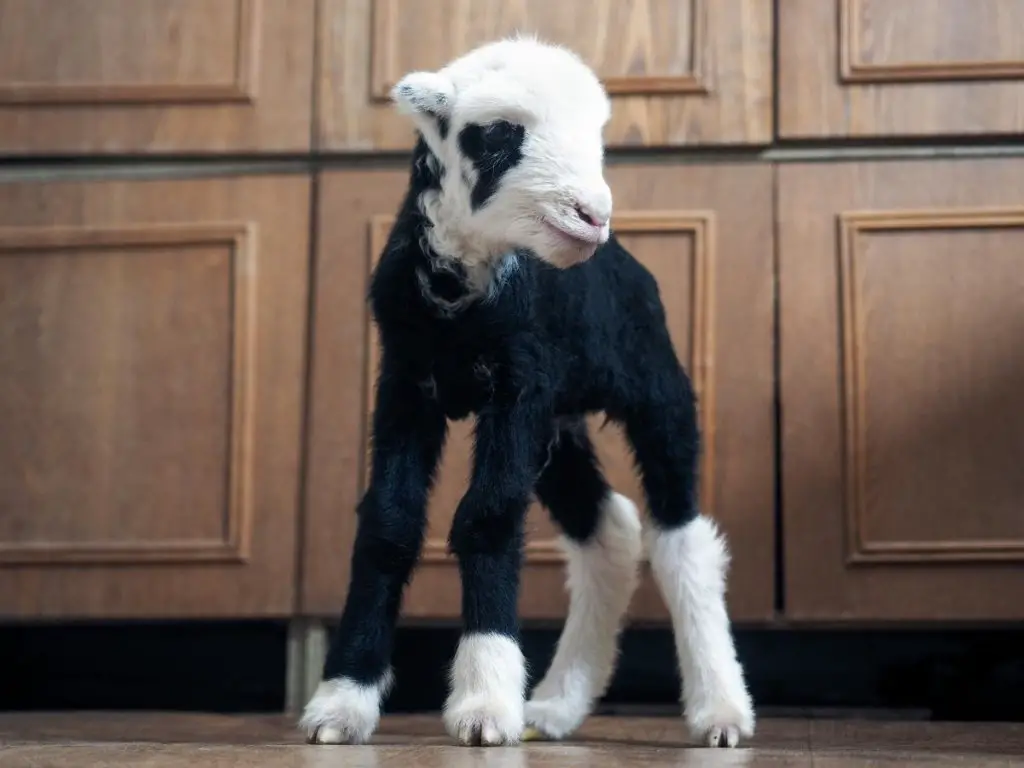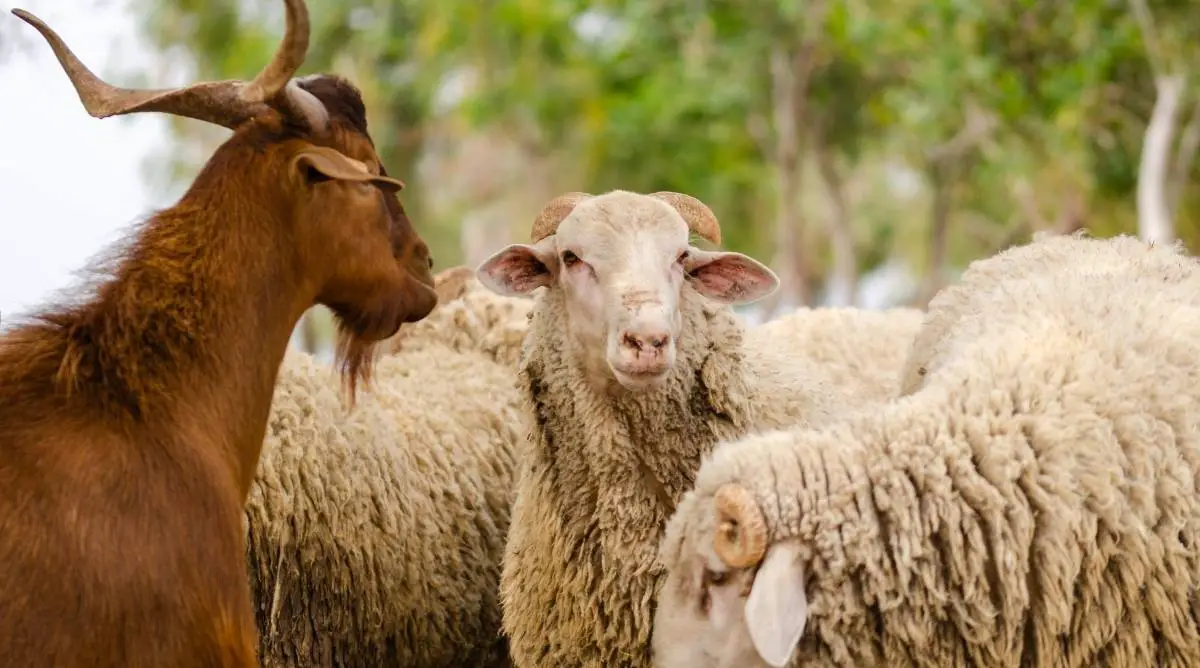While a sheep and a goat can mate, it doesn’t happen often. Usually, the pregnancy is not carried to full-term, or the offspring is born stillborn. There are a few confirmed cases of live “geeps”—the hybrid offspring of sheep and goats.
Table of Contents
Can a sheep and a goat mate?
Yes, sheep and goats can mate, but it’s unusual. Mating is uncommon even when they are pastured together, because of the differences in their genetics.
The rare offspring of a sheep and goat successfully mating produce a sheep-goat hybrid known as a ‘geep’. There are a few recorded cases of successful natural breeding. More commonly, the female does not carry the pregnancy to term, or the hybrid offspring is born stillborn.
How are Sheep and Goats Different?
Sheep and goats differ not only in appearance and behavior but also genetically.
| Characteristics | Sheep | Goats |
| Physical Appearance | Divided upper lip, woolly coats, and long tails that hang down. | Short tails that point upward and no wool. Some male goats have beards. |
| Chromosome pairs | 54 | 60 |
| Taxonomy | Bovidae family, Caprinae subfamily, Ories genus, Ories Aries species | Bovidae family, Caprinae subfamily, Capra genus, Capra aegagrus hircus species |
| Mating | Rams don’t have a scent during mating season | Male goats have a strong odor during mating season |
Physical Appearance & Characteristics
Sheep have a divided upper lip, woolly coats, and long tails that hang down. Goats have short tails that point upward and do not have wool. Some male goats have beards. Male goats develop a strong odor during mating season while male sheep (rams) do not.
Taxonomy
Sheep and goats belong to the same ruminant family (Bovidae) and subfamily (Caprinae). However, each comes from a distinct genus and species. Sheep belong to the Ories genus and Ories Aries species. Goats come from the Capra genus and Capra aegagrus hircus species.
Genetics
Sheep and goats come from different genetic pools. Sheep have 54 chromosome pairs, while goats have 60. Because of this notable genetic difference, most sheep-goat hybrids don’t survive.
The six chromosomal pair difference often results in :
- Stillbirths
- Pregnancies not being carried to term
- Live geeps that are unable to reproduce
Sheep-goat hybrids (geep)

Sheep-goat hybrids are also known as geeps. Breeding a male sheep with a female goat produces more viable offspring than a male goat with a female sheep.
The hybrids produced usually have an intermediate number of chromosomes that differ from their parent species. Because of the difference in species between the parents, live geeps usually cannot reproduce and have health complications after birth.
Successful Cases of Live Sheep-Goat Hybrids
There are a few confirmed cases of live geeps being born after a sheep and goat mate:
- United States – Spring Rose is one of the first genetically tested and confirmed geeps. She was produced after a Babydoll male sheep accidentally bred with a Nigerian dwarf female goat in Allen County, Kentucky. She has 57 chromosomes.
- New Zealand – a female goat and a ram (male sheep) naturally bred and produced a female geep. The female hybrid has 57 chromosomes. She successfully mated with a ram.
- Ireland – In 2018, on a farm in County Mayo, a sheep and goat mated to produce the first recorded twin sheep-goat hybrids named ‘This’ and ‘That.’
- Botswana – In 2000, at the Botswana Ministry of Agriculture, a male sheep mated with a female goat resulting in a live male hybrid. The hybrid had 57 chromosomes, was infertile, but had a very active libido.
- Czech Republic – In 2020, a female hybrid was born on a farm in Tábor. She had many health complications after birth.
Hybridization of animals
The main goal of hybridization is to produce an animal with better traits than its parents. Breeders also use targeted breeding to transfer desired characteristics from two species into one group of animals or from one species to another.
For example, when a female horse mates with a male donkey, they produce a mule. The mule is strong like a donkey and intelligent like its horse parent, making it an excellent hybrid for carrying supplies. Another example of hybridization is when a male lion and a female tiger produce a liger.
When animals breed, the progeny takes 50% of the genetic composition of each parent. For organisms within the same species, their offspring will closely resemble them because they all share the same genes and traits. Also, such a progeny will have few mutations.
For organisms from a different genus or species, the offspring will have separate genetic instructions from its parents. The progeny will have more mutations, resulting in an individual that does not closely resemble its parents physically and genetically.
Parents with less genetic information shared result in a less healthy and infertile breed.
Animal hybridization can be:
- Natural
- Experimental
- Interventional
Natural Hybridization
Animals from different species can naturally mate if they have a shared territory. For example, wild goats can impregnate ewes. Also, a male sheep can mate with a female goat kept on the same farm.
Natural hybridization may also happen in the wild if the animals have a similar genetic structure.
Experimental Hybridization
Experimental hybridization involves external help to breed the two species. Organisms mated using the experimental method would rarely reproduce naturally.
In most cases, the progeny is sterile and has health issues. In some cases, one sex of the offspring ends up viable while the other does not. For example, in the case of ligers – a male lion bred with a female tiger – the female offspring is fertile while the male is not.
Dr. Gary Anderson, a distinguished professor emeritus at the University of California, Davis, is known for his experimental hybridization research that involved in-vitro manipulation of embryos to create geeps. “Chimera” is what he preferred calling his sheep-goat hybrids.
Interventional Hybridization
Interventional hybridization involves using various organisms’ genetic codes to save an animal species from extinction.

